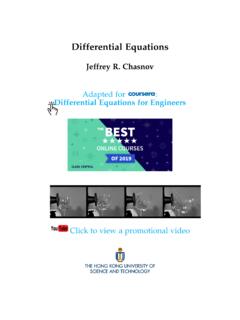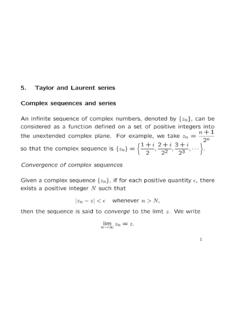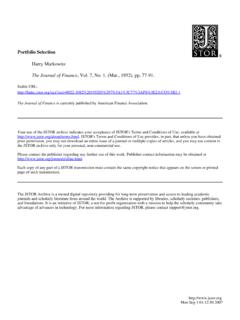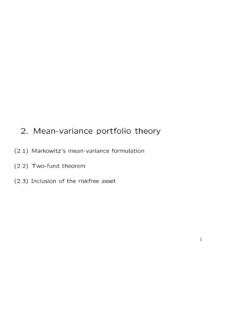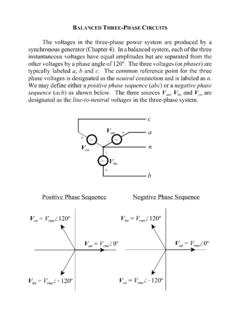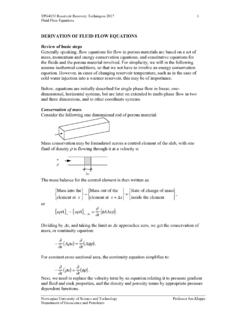Transcription of Differential Equations for Engineers
1 Differential Equations for Engineers Lecture Notes for Jeffrey R. Chasnov The Hong Kong University of Science and Technology Department of Mathematics Clear Water Bay, Kowloon Hong Kong Copyright . c 2019 by Jeffrey Robert Chasnov This work is licensed under the Creative Commons Attribution Hong Kong License. To view a copy of this license, visit or send a letter to Creative Commons, 171 Second Street, Suite 300, San Francisco, California, 94105, USA. Preface View the promotional video on YouTube These are my lecture notes for my online Coursera course, Differential Equations for Engineers .
2 I. have divided these notes into chapters called Lectures, with each Lecture corresponding to a video on Coursera. I have also uploaded all my Coursera videos to YouTube, and links are placed at the top of each Lecture. There are problems at the end of each lecture chapter and I have tried to choose problems that exemplify the main idea of the lecture. Students taking a formal university course in Differential Equations will usually be assigned many more additional problems, but here I follow the philosophy that less is more. I give enough problems for students to solidify their understanding of the material, but not too many problems that students feel overwhelmed and drop out.
3 I do encourage students to attempt the given problems, but if they get stuck, full solutions can be found in the Appendix. There are also additional problems at the end of coherent sections that are given as practice quizzes on the Coursera platform. Again, students should attempt these quizzes on the platform, but if a student has trouble obtaining a correct answer, full solutions are also found in the Appendix. Students who take this course are expected to know single-variable Differential and integral calcu- lus. Some knowledge of complex numbers, matrix algebra and vector calculus is required for parts of this course.
4 Students missing this latter knowledge can find the necessary material in the Appendix. Jeffrey R. Chasnov Hong Kong January 2019. iii Contents 1 Introduction to Differential Equations 1. Practice quiz: Classify Differential Equations 3. I First-Order Differential Equations 5. 2 Euler method 9. 3 Separable first-order Equations 11. 4 Separable first-order equation: example 13. Practice quiz: Separable first-order odes 15. 5 Linear first-order Equations 17. 6 Linear first-order equation: example 19. Practice quiz: Linear first-order odes 21. 7 Application: compound interest 23.
5 8 Application: terminal velocity 25. 9 Application: RC circuit 27. Practice quiz: Applications 31. II Homogeneous Linear Differential Equations 33. 10 Euler method for higher-order odes 37. 11 The principle of superposition 39. 12 The Wronskian 41. 13 Homogeneous second-order ode with constant coefficients 43. Practice quiz: Superposition, the Wronskian, and the characteristic equation 45. v vi CONTENTS. 14 Case 1: Distinct real roots 47. 15 Case 2: Complex-conjugate roots (Part A) 49. 16 Case 2: Complex-conjugate roots (Part B) 51. 17 Case 3: Repeated roots (Part A) 53.
6 18 Case 3: Repeated roots (Part B) 55. Practice quiz: Homogeneous Equations 57. III Inhomogeneous Linear Differential Equations 59. 19 Inhomogeneous second-order ode 63. 20 Inhomogeneous term: Exponential function 65. Practice quiz: Solving inhomogeneous Equations 67. 21 Inhomogeneous term: Sine or cosine (Part A) 69. 22 Inhomogeneous term: Sine or cosine (Part B) 71. 23 Inhomogeneous term: Polynomials 73. Practice quiz: Particular solutions 75. 24 Resonance 77. 25 Application: RLC circuit 79. 26 Application: Mass on a spring 83. 27 Application: Pendulum 85.
7 28 Damped resonance 87. Practice quiz: Applications and resonance 89. IV The Laplace Transform and Series Solution Methods 91. 29 Definition of the Laplace transform 95. 30 Laplace transform of a constant-coefficient ode 97. 31 Solution of an initial value problem 99. Practice quiz: The Laplace transform method 101. 32 The Heaviside step function 103. 33 The Dirac delta function 105. CONTENTS vii 34 Solution of a discontinuous inhomogeneous term 107. 35 Solution of an impulsive inhomogeneous term 109. Practice quiz: Discontinuous and impulsive inhomogeneous terms 111.
8 36 The series solution method 113. 37 Series solution of the Airy's equation (Part A) 117. 38 Series solution of the Airy's equation (Part B) 121. Practice quiz: Series solutions 123. V Systems of Differential Equations 125. 39 Systems of linear first-order odes 129. 40 Distinct real eigenvalues 131. 41 Complex-conjugate eigenvalues 133. Practice quiz: Systems of Differential Equations 135. 42 Phase portraits 137. 43 Stable and unstable nodes 139. 44 Saddle points 141. 45 Spiral points 143. Practice quiz: Phase portraits 145. 46 Coupled oscillators 147. 47 Normal modes (eigenvalues) 149.
9 48 Normal modes (eigenvectors) 151. Practice quiz: Normal modes 153. VI Partial Differential Equations 155. 49 Fourier series 159. 50 Fourier sine and cosine series 161. 51 Fourier series: example 163. Practice quiz: Fourier series 165. 52 The diffusion equation 167. viii CONTENTS. 53 Solution of the diffusion equation (separation of variables) 169. 54 Solution of the diffusion equation (eigenvalues) 171. Practice quiz: Separable partial Differential Equations 173. 55 Solution of the diffusion equation (Fourier series) 175. 56 Diffusion equation: example 177.
10 Practice quiz: The diffusion equation 179. Appendix 180. A Complex numbers 183. B Nondimensionalization 185. C Matrices and determinants 187. D Eigenvalues and eigenvectors 189. E Partial derivatives 191. F Table of Laplace transforms 193. G Problem and practice quiz solutions 195. Lecture 1. Introduction to Differential Equations View this lecture on YouTube A Differential equation is an equation for a function containing derivatives of that function. For exam- ple, the Differential Equations for an RLC circuit, a pendulum, and a diffusing dye are given by d2 q dq 1.

